

11 Hilarious Hoax Sites to Test Website Evaluation. In this day and age, where anyone with access to the internet can create a website, it is critical that we as educators teach our students how to evaluate web content.
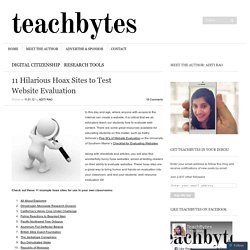
There are some great resources available for educating students on this matter, such as Kathy Schrock’s Five W’s of Website Evaluation or the University of Southern Maine’s Checklist for Evaluating Websites. Along with checklists and articles, you will also find wonderfully funny hoax websites, aimed at testing readers on their ability to evaluate websites. Code of Digital Conduct « Library Learning Commons. Sites/default/files/Framing-document-formatted.pdf. Definition Of Digital Citzenship. The Definition Of Digital Citizenship by Terry Heick As more and more students interact digitally–with content, one another, and various communities–the concept of digital citizenship becomes increasingly important.
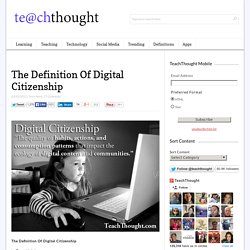
Which begs the question: what is digital citizenship? Well, first citizenship, which is formally defined as “the quality of an individual’s response to membership in a community.” This makes citizenship far more complex than a simple legal matter, but rather one that consists of self-knowledge, interaction, and intimate knowledge of a place, its people, and its cultural history. The Importance of Teaching Digital Citizenship. This week I am giving some guest bloggers the opportunity to share their ideas with you.

Digital Literacy. Digital technology is changing the way our kids think, learn, and interact with each other, and digital skills are what kids need to be prepared for their futures.
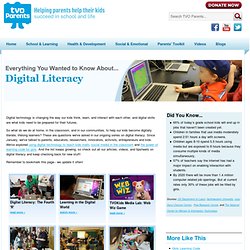
So what do we do at home, in the classroom, and in our communities, to help our kids become digitally literate, lifelong learners? These are questions we've asked in our ongoing series on digital literacy. Since January, we've talked to parents, educators, researchers, innovators, activists, entrepreneurs and kids. How to Infuse Digital Literacy Throughout the Curriculum. Understanding Digital Citizenship & Identity - Updated March 14. Should Schools Teach Social Media Skills? Teaching Strategies MKHMarketing By Aarti Shahani Taking selfies at funerals.
Tagging pictures of teens drinking alcohol at parties. Kids (and adults for that matter) post a lot of silly stuff online — and although most of it is chatter, some of what might seem harmless leads to tragic consequences. At Lincoln High School in San Francisco’s Sunset district, counselor Ian Enriquez teaches students three very big words: “Disinhibition, reputation, anonymity.” Enriquez is using a curriculum created by the non-profit Common Sense Media, a media watchdog group for parents that also offers resources for teachers.
Origin - Social Media. Make Cyber Safety a Priority. An alarming trend is gaining ground in our elementary schools: teachers using social media in the classroom.

Now before you cite all the wonderful statistics about how it improves academic performance and engages students, I’ll beat you to the punch. They’re right here (click for article with infographics). I understand the power of social media in education. The same power it has to turbo boost customer loyalty for a brand is the same power it has to engage students in learning. The danger is not in the concept—the danger is in the application. The article I referenced above has no discussion of responsible use. 1. Proper procedures for setting up a classroom social media channel. EAVI EN - A Journey to Media Literacy. Excellent Classroom Poster on How to Cite Information from Internet. K-12 Digital Literacy & Citizenship Curriculum.
Research on Social Media in Education « Josie Ahlquist. As part of my doctoral program in Higher Education Leadership, I took a class called Literature Review.
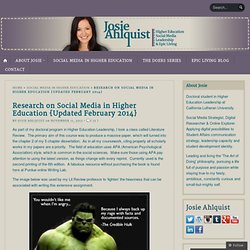
The primary aim of this course was to produce a massive paper, which will turned into the chapter 2 of my 5 chapter dissertation. As in all my coursework, citing properly all scholarly works in my papers are a priority. The field of education uses APA (American Psychological Association) style, which is common in the social sciences. The Code of Best Practices in Fair Use for Media Literacy Education. Coordinated by: The Media Education Lab, Temple University The Program on Information Justice and Intellectual Property, American University Washington College of Law The Center for Media & Social Impact, American University.
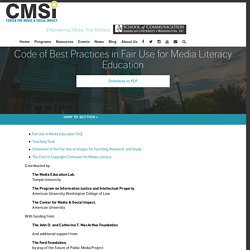
Through the Wild Web Woods - A game by the Council of Europe based on the Internet Literacy Handbook. Think B4 U Post. I ran across this image on Flickr.

I’m posting it here on my blog for sharing and also so that I don’t lose it. I think it would be perfect for printing and posting on a classroom wall for anyone using social media in the classroom. The image is licensed under a Creative Commons attribution license by Garry Baker, Hiromi Hosoi, Joy Seed & Mitch Norris. The product is very well done. Quick Answers—References. Files.solution-tree.com/pdfs/Reproducibles_TTiG/commentinginanasynchronousconversation. How To Use Crowdsourcing In The Classroom. The Connected Student Series Crowdsourcing is an important information literacy skill.
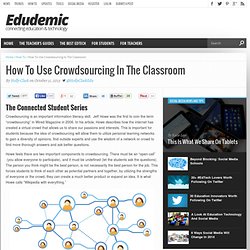
Jeff Howe was the first to coin the term “crowdsourcing” in Wired Magazine in 2006. In his article, Howe describes how the internet has created a virtual crowd that allows us to share our passions and interests. This is important for students because the idea of crowdsourcing will allow them to utilize personal learning networks to gain a diversity of opinions, find outside experts and use the wisdom of a network or crowd to find more thorough answers and ask better questions.